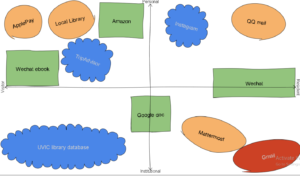In my perspective, I consider my PLN diverse, but I have remained relatively inactive within my PLN. Since I major in French literature, I spend most of my time reading and exploring literature, philosophy, and history. Although I participate in a silo of information sharing events, I tend to listen to others without expressing my ideas. Besides necessary communications in team projects, I prefer to study and ponder alone. Consequently, I shaped a passive learning pattern as time passes. Therefore, when I was concerned when I first heard about inclusive learning from the videos. I was afraid of bringing my passive learning habit into my future teaching as an educator.
In the video, Moore argues that inclusive teaching is to teach based on the recognition of “we are all diverse.” She also stresses the importance of volunteering will in inclusive teaching. Her point really strikes me, and I couldn’t agree more. Sometimes, teachers could unintentionally ignore students’ motivation and experience in designing and exercising curriculum. She talks about her regret of forcing her students to participate in a pep rally for an inclusive purpose, yet the students were not motivated to participate. Most of the students do not know their purpose of attending school and thus feel less motivated when forced to attend events. Teachers could start with encouraging students to discover their talents and strengths. Moore argues that the focus on strengths instead of deficits is the key in teaching to diversity. (Moore, 9) It also allows teachers to know the students better.
After reviewing videos and readings, I learned that I need to motivate students to explore their interests and strengths. Only by recognizing students’ talents and diversity on a volunteering basis, teachers could build an inclusive environment for learning.
Reference:
Moore, S., Miller, J. (2021, February 07). EDCI 338 A01 Week 5 A Conversation with Shelley Moore. February 14, 2021, YouTube. https://www.youtube.com/watch?v=YGx0ejnMLVc&feature=youtu.be
Moore, Shelley. One Without the Other: Stories of Unity Through Diversity and Inclusion, Portage & Main Press, 2017. ProQuest Ebook Central, https://ebookcentral-proquest-com.ezproxy.library.uvic.ca/lib/uvic/detail.action? docID=4832579.
